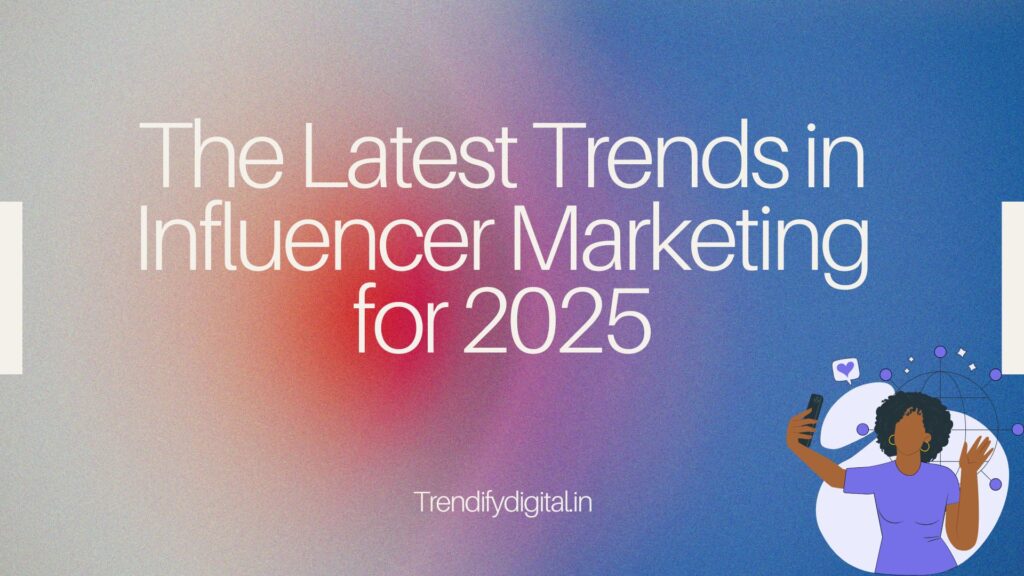The Latest Trends in Influencer Marketing for 2025
The Latest Trends in Influencer Marketing for 2025 Influencer marketing continues to evolve, with brands and creators adopting new strategies to stay ahead. In 2025, the focus is on authenticity, technology, and innovative content formats. Here are the top influencer marketing trends shaping the industry this year. 1. Rise of Nano and Micro-Influencers While mega-influencers and celebrities still play a role, brands are now turning to nano (1K–10K followers) and micro-influencers (10K–100K followers) for more authentic engagement. These influencers tend to have niche audiences and higher trust levels, making them more effective for conversions. Why Brands Prefer Smaller Influencers: Example: A skincare brand collaborating with a micro-influencer who specializes in clean beauty can drive higher engagement than a celebrity endorsement. 2. AI-Driven Influencer Discovery and Campaigns Artificial Intelligence (AI) is revolutionizing influencer marketing by helping brands identify the right influencers and measure campaign success. AI-powered platforms analyze engagement rates, audience demographics, and brand alignment to select the best influencers for a campaign. How AI Enhances Influencer Marketing: Example: Brands using AI tools like Upfluence or HypeAuditor can quickly find the best influencer matches based on data-driven insights. 3. Growth of Live Shopping and Social Commerce Live shopping is booming, with influencers hosting real-time product showcases on platforms like Instagram, TikTok, and YouTube. This trend allows audiences to interact directly, ask questions, and make instant purchases. Why Live Shopping Works: Example: A fashion influencer hosting a live try-on session on TikTok can encourage followers to purchase featured outfits instantly. 4. Focus on Authenticity and Long-Term Partnerships Consumers today demand genuine recommendations, and brands are shifting from one-time sponsored posts to long-term collaborations with influencers. This builds credibility and helps brands establish trust over time. How to Foster Authentic Partnerships: Example: A fitness brand working with an influencer for a 12-month campaign sees more sustained brand awareness than a single sponsored post. 5. Expansion of Influencer Marketing in B2B While influencer marketing is traditionally linked to B2C, B2B brands are now leveraging industry experts, thought leaders, and niche professionals to reach decision-makers. B2B Influencer Strategies Include: Example: A software company partnering with a LinkedIn influencer to discuss cybersecurity trends can generate leads among business professionals. 6. Rise of CGI and Virtual Influencers Virtual influencers like Lil Miquela and Imma are gaining traction as brands experiment with AI-generated personalities to engage audiences in unique ways. Benefits of Virtual Influencers: Example: A fashion brand using a CGI model to showcase digital clothing collections in the metaverse. 7. Increased Emphasis on Diversity and Inclusion Consumers expect brands to be inclusive, and influencer marketing is reflecting this shift. Companies are actively working with influencers from diverse backgrounds, representing various ethnicities, body types, and abilities. How Brands Are Prioritizing Inclusivity: Example: A beauty brand featuring influencers of all skin tones to promote an inclusive foundation line. 8. Performance-Based Collaborations Over Flat Fees Instead of paying influencers a fixed fee upfront, brands are shifting toward performance-based compensation models, rewarding influencers for engagement, clicks, and conversions. Types of Performance-Based Models: Example: An e-commerce brand providing influencers with personalized discount codes and paying them a percentage of each sale generated. 9. Rise of Short-Form Video Content Short videos on TikTok, Instagram Reels, and YouTube Shorts continue to dominate influencer marketing. These bite-sized clips allow brands to create engaging and easily digestible content. Best Practices for Short-Form Videos: Example: A travel influencer sharing a “Top 5 Destinations of 2025” in a 30-second Instagram Reel. 10. Stricter Regulations and Transparent Advertising Governments and social platforms are enforcing stricter regulations on influencer marketing to ensure transparency and protect consumers from misleading promotions. Compliance Best Practices: Example: An influencer promoting a skincare product must openly disclose any sponsorship to maintain trust with followers. Conclusion Influencer marketing is no longer just about follower count; it’s about authenticity, engagement, and innovation. From nano-influencers to AI-powered campaigns, brands must adapt to these trends to stay ahead in 2025. Key Takeaways: By embracing these trends, brands can build more effective and trustworthy influencer marketing strategies in the ever-evolving digital landscape. For more such content check out more article here Trendify Digital Facebook page: Trendify Digital Instagram Page: Trendify Digital
The Latest Trends in Influencer Marketing for 2025 Read More »
Social Media Marketing